COVID-19 pandemic in Portugal
The COVID-19 pandemic in Portugal is part of the worldwide pandemic of coronavirus disease 2019 (COVID-19) caused by severe acute respiratory syndrome coronavirus 2 (SARS-CoV-2). On 2 March 2020, the virus was confirmed to have reached Portugal, when it was reported that two men, a 60-year-old doctor who travelled to the north of Italy on vacation and a 33-year-old man working in Spain, tested positive for COVID-19.[2][3]
| COVID-19 pandemic in Portugal | |||||||||||
|---|---|---|---|---|---|---|---|---|---|---|---|
 Map of municipalities with coronavirus cases (as of 26 June 2020):[1]
| |||||||||||
| Disease | COVID-19 | ||||||||||
| Virus strain | SARS-CoV-2 | ||||||||||
| Location | Portugal | ||||||||||
| First outbreak | Wuhan, Hubei, China | ||||||||||
| Index case | Porto | ||||||||||
| Arrival date | 2 March 2020 (5 months, 2 weeks and 2 days) | ||||||||||
| Confirmed cases | 54,448[1] | ||||||||||
| Active cases | 12,728[1] | ||||||||||
| Suspected cases‡ | 468,937[1] | ||||||||||
| Severe cases | 38[1] | ||||||||||
| Hospitalized cases | 336[1] | ||||||||||
| Recovered | 39,936[1] | ||||||||||
Deaths | 1,784[1] | ||||||||||
| Fatality rate | 3.28% | ||||||||||
| Government website | |||||||||||
| covid19 | |||||||||||
| ‡Suspected cases have not been confirmed as being due to this strain by laboratory tests, although some other strains may have been ruled out. | |||||||||||
Background
On 12 January 2020, the World Health Organization (WHO) confirmed that a novel coronavirus was the cause of a respiratory illness in a cluster of people in Wuhan City, Hubei Province, China, which was reported to the WHO on 31 December 2019.[4][5]
The case fatality ratio for COVID-19 has been much lower than SARS of 2003,[6][7] but the transmission has been significantly greater, with a significant total death toll.[8][6]
Timeline
March
- March 2: first recorded cases of COVID-19 in Portugal.
- March 12: The Portuguese government declared the highest level of alert because of COVID-19 and said it would be maintained until 9 April.[10] Portugal entered a Mitigation Phase as Community transmission was detected.
- March 18: The President of the Republic, Marcelo Rebelo de Sousa, declared the entirety of the Portuguese territory in a State of Emergency for the following fifteen days, with the possibility of renewal, the first since the Carnation Revolution in 1974.[11]
- March 24: The Portuguese Government admitted that the country could not contain the virus any longer.
- March 26: The country entered the "Mitigation Stage". The health care sites dedicated to fighting the disease started including the Portugal Health centres groups (agrupamentos de centros de saúde, ACES).[12]
April
- April 2: The Parliament approved[13] the extension of the State of Emergency, as requested by the President.[14] The State of Emergency will remain until 17 April, subject to further extensions of similar duration. Under the new regulations, for the Easter celebrations, from 9 April (Maundy Thursday) to 13 April (Easter Monday) the Portuguese Government decreed special measures in restricting people movements between municipalities (Portuguese: municípios or concelhos) with very few exceptions, closing all airports to civil transportation and increased control in the national borders.
- April 30: The Portuguese Ministers' Council approved a plan to start releasing the country from the COVID-19 container measures and cancelling the State of Emergency.[15]
May
- May 2: The State of Emergency was canceled.
- May 4: Portugal started the first phase in easing restrictions. Small street stores reopened. (see Response, Return to Normal section).
- May 18: Portugal entered the second phase in easing restrictions. Nurseries and the last two years of the secondary school reopened, along with restaurants, cafés, medium-sized street stores and some museums, all with mandatory usage of mask and distance rules.
Response
Information access
Information about the ongoing COVID-19 pandemic in the country is hosted on the DGS home website.[16] However, due to the severity of the pandemic a separate website was created dedicated specifically to coronavirus information and updates under the Portuguese Ministry of Health.[17] Another governmental website was later created to deal with more generic information explaining the emergency status, public information and exceptional measures to help business.[18]
The Ministry of Health provides a web page with information for the public about different areas,[19] including brochures, orientation and guidance for different activity sectors, how to deal with self-isolation, and quarantine games for children. As an example there are several Portuguese food recipes with canned food.[20]
Hospitals for COVID-19
The following is a list of the front line COVID-19 hospitals.[21]
| Region | Hospital | Adults | Pediatric |
|---|---|---|---|
| Northern | Braga | ||
| Santo António | |||
| São João | |||
| Pedro Hispano | |||
| Central | CHU Coimbra | ||
| ULS Guarda | |||
| Lisbon and Tagus Valley |
Santa Maria | ||
| Curry Cabral | |||
| Dona Estefânia | |||
| Algarve | Faro | ||
| Madeira | Dr. Nélio Mendonça | ||
| Azores | Santo Espírito (Terceira) |
Return to normal
On April 30 the Portuguese Ministers' Council approved a plan to start releasing the country from COVID-19 containment measures and cancel the State of Emergency.[15] The plan was divided in three stages, beginning respectively on 4 May, 18 May and 1 June.

The first stage eased some restrictions,[22] such as
- Barbers and hair salons are open but with health restrictions, mask usage and only by appointment
- Small shops with less than 200m2 can open but cannot have more than 5 customers/100m2 and all must use masks
- People can use public transportation if they aren't able to work remotely. Transport vehicles can only be filled to two thirds capacity and all passengers must use a mask
- All public services are open to everyone with an appointment and is an obligation the use of a mask
- Physical exercise can only be done outdoors or at home
- Libraries and Archives are open
- Groups of more than 10 people aren't allowed
Impact
Due to movement restrictions imposed by the state of emergency started in March 18 and the adoption of government guidelines on social distancing by the Portuguese people, otherwise highly populated streets and destinations in cities like Lisbon and Porto were completely empty.[23][24]
Statistics
The following graphs show the evolution of the pandemic starting from 2 March 2020, the day the first cases were confirmed in the country[25].
Total confirmed cases
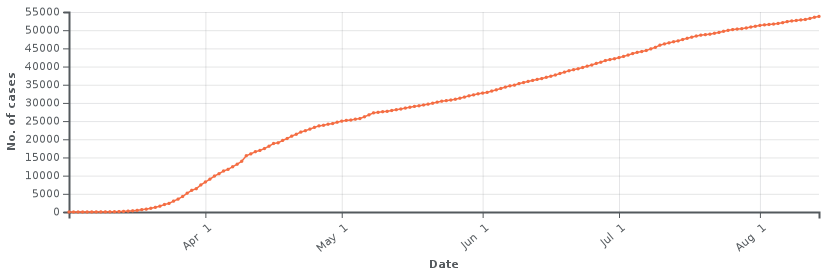
New cases per week

Total confirmed cases by age and gender
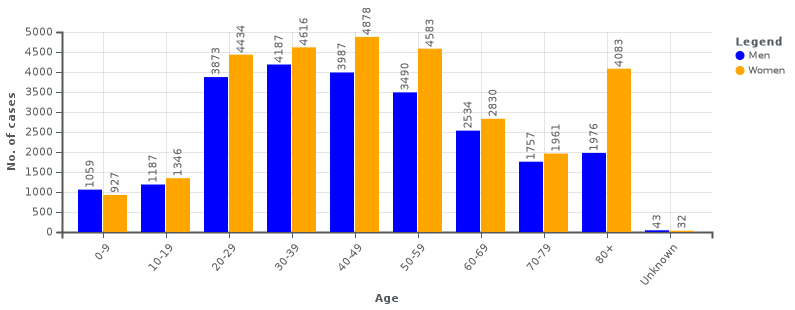
Total confirmed recoveries
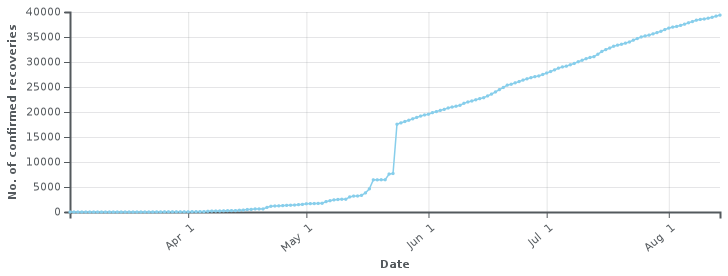
Total confirmed deaths

New deaths per week
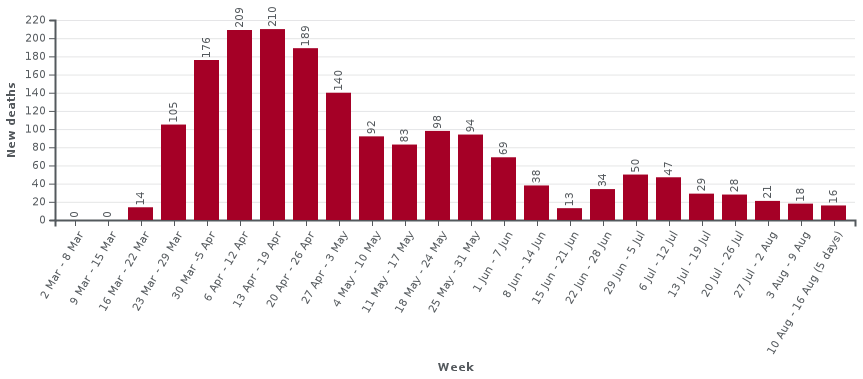
Total confirmed deaths by age and gender
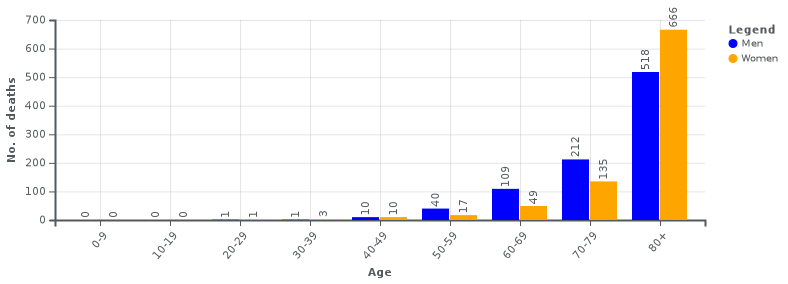
References
- "Ponto de Situação em Portugal". covid19.min-saude.pt (in Portuguese).
- "Ministra confirma primeiro caso positivo de coronavirus em Portugal". Expresso. 2 March 2020.
- "Confirmados dois primeros casos de contágio pelo novo coronavirus em Portugal". TSF.
- Elsevier. "Novel Coronavirus Information Center". Elsevier Connect. Archived from the original on 30 January 2020. Retrieved 15 March 2020.
- Reynolds, Matt (4 March 2020). "What is coronavirus and how close is it to becoming a pandemic?". Wired UK. ISSN 1357-0978. Archived from the original on 5 March 2020. Retrieved 5 March 2020.
- "Crunching the numbers for coronavirus". Imperial News. Archived from the original on 19 March 2020. Retrieved 15 March 2020.
- "High consequence infectious diseases (HCID); Guidance and information about high consequence infectious diseases and their management in England". GOV.UK. Archived from the original on 3 March 2020. Retrieved 17 March 2020.
- "World Federation Of Societies of Anaesthesiologists – Coronavirus". www.wfsahq.org. Archived from the original on 12 March 2020. Retrieved 15 March 2020.
- "Covid-19. Estado de alerta até pelo menos 9 de abril". Expresso. 13 March 2020. Retrieved 13 March 2020.
- "Mensagem do Presidente da República ao País sobre a declaração do estado de emergência (Palácio de Belém, 18 de março de 2020)" [Message of the President of the Republic to the Country on the declaration of a state of emergency]. Presidency of the Portuguese Republic (in Portuguese). 18 March 2020. Retrieved 18 March 2020.
- "Portugal em fase de mitigação a partir de quinta-feira". Expresso (in Portuguese). 24 March 2020.
- "Parlamento aprova prolongamento do estado de emergência até 17 de abril". Sapo (in Portuguese). 2 April 2020. Retrieved 2 April 2020.
- "Projeto do Decreto do Presidente da República de Renovação do Estado de Emergência" (PDF) (in Portuguese). Cite journal requires
|journal=(help) - "Plano de desconfinamento em Portugal: conheça aqui todas as datas e medidas". Sic Notíicias. 30 April 2020. Retrieved 4 May 2020.
- "DGS website". Direção-Geral da Saúde.
- "COVID-19 - Página Inicial". covid19.min-saude.pt.
- Estamos On (We are ON)
- "Materiais de Divulgação - COVID-19". covid19.min-saude.pt.
- "Receitas Enlatados Isolamento" (PDF).
- "Coronavírus: A que hospital pode ir e quais os que aceitam crianças". Impala (in Portuguese). Worldimpala.net (Impala Capital, Consultadoria de Gestão; Impala.Com - Soc. Gestora de Participações Sociais). 11 March 2020. Archived from the original on 10 May 2020.
- "Isto é tudo o que pode voltar a fazer a partir desta segunda-feira". Jornal Expresso. 4 May 2020.
- "Um vírus na cidade chamado silêncio". Jornal de Notícias. 25 March 2020.
- "Portugal set to quarantine arrivals from abroad as streets empty out". Reuters. 20 March 2020.
- "Coronavírus: há dois casos confirmados em Portugal". Público. 2 March 2020.
External links
- COVID-19 - Direção-Geral da Saúde (by the Directorate-General of Health)
- EstamosON - Official Information COVID19 Estamos On (gov.pt) (by the Portuguese government)
- Esri Portugal - Evolution of COVID-19 in Portugal with graphs and data
- "Coronavirus Portugal updates and news" [Latest news and statistics of coronavirus in Portugal.] (in English, French, Spanish, Portuguese, German, Italian, Swedish, Norwegian, Finnish, Estonian, and Russian). Retrieved 4 April 2020.
- Worldometers - Coronavirus (Covid-19 Data) - Portugal
- Repositório de dados Covid-19 em Portugal
- Vigilância da Mortalidade - Deaths statistics